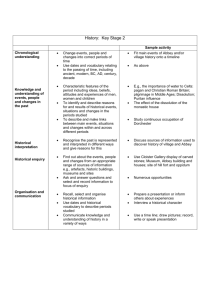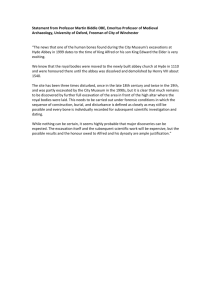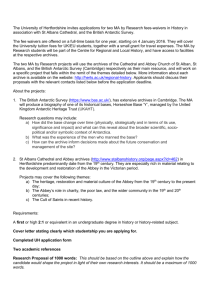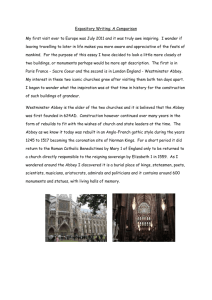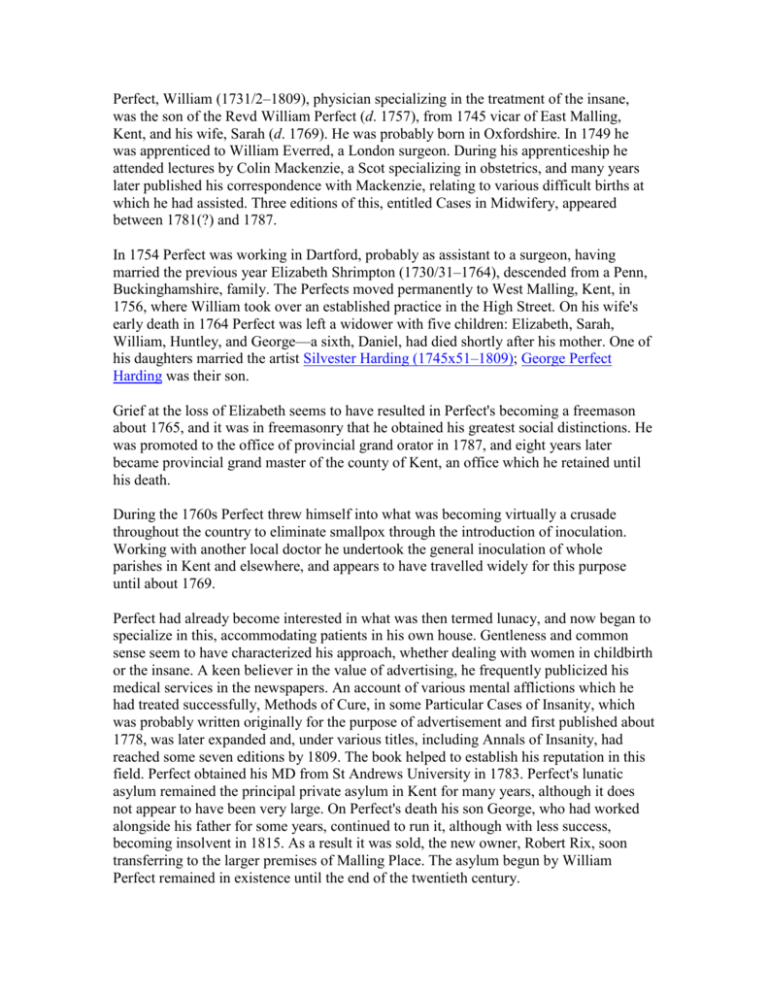
Perfect, William (1731/2–1809), physician specializing in the treatment of the insane,
was the son of the Revd William Perfect (d. 1757), from 1745 vicar of East Malling,
Kent, and his wife, Sarah (d. 1769). He was probably born in Oxfordshire. In 1749 he
was apprenticed to William Everred, a London surgeon. During his apprenticeship he
attended lectures by Colin Mackenzie, a Scot specializing in obstetrics, and many years
later published his correspondence with Mackenzie, relating to various difficult births at
which he had assisted. Three editions of this, entitled Cases in Midwifery, appeared
between 1781(?) and 1787.
In 1754 Perfect was working in Dartford, probably as assistant to a surgeon, having
married the previous year Elizabeth Shrimpton (1730/31–1764), descended from a Penn,
Buckinghamshire, family. The Perfects moved permanently to West Malling, Kent, in
1756, where William took over an established practice in the High Street. On his wife's
early death in 1764 Perfect was left a widower with five children: Elizabeth, Sarah,
William, Huntley, and George—a sixth, Daniel, had died shortly after his mother. One of
his daughters married the artist Silvester Harding (1745x51–1809); George Perfect
Harding was their son.
Grief at the loss of Elizabeth seems to have resulted in Perfect's becoming a freemason
about 1765, and it was in freemasonry that he obtained his greatest social distinctions. He
was promoted to the office of provincial grand orator in 1787, and eight years later
became provincial grand master of the county of Kent, an office which he retained until
his death.
During the 1760s Perfect threw himself into what was becoming virtually a crusade
throughout the country to eliminate smallpox through the introduction of inoculation.
Working with another local doctor he undertook the general inoculation of whole
parishes in Kent and elsewhere, and appears to have travelled widely for this purpose
until about 1769.
Perfect had already become interested in what was then termed lunacy, and now began to
specialize in this, accommodating patients in his own house. Gentleness and common
sense seem to have characterized his approach, whether dealing with women in childbirth
or the insane. A keen believer in the value of advertising, he frequently publicized his
medical services in the newspapers. An account of various mental afflictions which he
had treated successfully, Methods of Cure, in some Particular Cases of Insanity, which
was probably written originally for the purpose of advertisement and first published about
1778, was later expanded and, under various titles, including Annals of Insanity, had
reached some seven editions by 1809. The book helped to establish his reputation in this
field. Perfect obtained his MD from St Andrews University in 1783. Perfect's lunatic
asylum remained the principal private asylum in Kent for many years, although it does
not appear to have been very large. On Perfect's death his son George, who had worked
alongside his father for some years, continued to run it, although with less success,
becoming insolvent in 1815. As a result it was sold, the new owner, Robert Rix, soon
transferring to the larger premises of Malling Place. The asylum begun by William
Perfect remained in existence until the end of the twentieth century.
Perfect always enjoyed writing, both prose and verse: friends often received letters
couched in rhyme. In the 1750s and 1760s he seems to have been one of a coterie of
young scribblers who styled themselves Parnassians. These included William Woty, a
Chatham friend Folly Streeter, and John Nichols, the future printer and writer, a few of
whose poems appeared in Perfect's two-volume collection, The Laurel Wreath (1766).
This was the second of his literary publications. The first was A Bavin of Bays (1763).
Both books contained poems which had first appeared in one of several London
magazines to which Perfect was a contributor, particularly the General Magazine of Arts
and Sciences, the Political Chronicle, and the Westminster Journal. Perfect's work
continued to appear in the London press for many years, most of it signed with one of his
numerous pseudonyms. In September 1795 the Freemasons' Magazine carried the
‘Memoirs of William Perfect, M.D., member of the London Medical Society’, which are
useful for extending our knowledge of Perfect's medical output, though one or two items
are now no longer traceable, and others were never completed.
After his marriage about 1768 to a second wife, Henrietta (1745/6–1804), Perfect's
family increased by four more children: Folliott Augusta, Lucy, Thomas, and Almeria.
Following Henrietta's death, at the age of fifty-eight, Perfect married again, about 1805,
his third wife being almost certainly Elizabeth Selby (1767–1851), of West Malling. He
became ill in that year, however, and although able to officiate as provincial grand master
in 1806, his health deteriorated from then on. Perfect died at home, in High Street, West
Malling, on 5 June 1809, and was buried on 17 June with masonic rites in the vault in
East Malling churchyard which he had had built some years earlier to commemorate his
father and grandfather, both buried in East Malling church.
Shirley Burgoyne Black
Sources
S. B. Black, An eighteenth century mad-doctor: William Perfect of West Malling (1995) ·
S. Pope, ‘Freemasonry in Canterbury and provincial grand lodge, 1785–1809, and Dr
Perfect, provincial grand master of Kent 1795–1809’, Ars Quatuor Coronatorum, 52
(1939), 6–58 · ‘Memoirs of William Perfect, M.D., member of the London Medical
Society’, Freemasons' Magazine, 5 (1795), 147–51 · Masonic Museum and Library,
Canterbury, William Perfect MSS, 9 folio vols., 1754–1773 · P. J. Wallis and R. V.
Wallis, Eighteenth century medics, 2nd edn (1988) · General Magazine of Arts and
Sciences: miscellaneous correspondence, 1755–1760, 4 vols. (1759–64) · Vicar-general
marriage allegations, LPL · GM, 1st ser., 79 (1809), 684 · GM, 1st ser., 74 (1804)
[Henrietta Perfect]
Archives
Masonic Museum and Library, Canterbury
Likenesses
M. W. Sharp, oils, c.1796, Masonic Museum and Library, Canterbury · W. S. Leney,
engraving, repro. in Black, An eighteenth century mad-doctor · W. Say, mezzotint (after
M. W. Sharp, c.1796), BM
© Oxford University Press 2004–5
All rights reserved: see legal notice
Shirley Burgoyne Black, ‘Perfect, William (1731/2–1809)’,
Oxford Dictionary of National Biography, Oxford University
Press, 2004 [http://www.oxforddnb.com/view/article/58530,
accessed 2 Oct 2006]
William Perfect (1731/2–1809): doi:10.1093/ref:odnb/58530
Back to top of biography
Site credits
Sir Richard Westmacott (1775–1856), by James
Thomson, pubd 1823 (after William Derby, 1822)
Westmacott, Sir Richard (1775–1856), sculptor, was born in Grosvenor Square,
Westminster, London, on 15 July 1775, the eldest of the thirteen children of the sculptor
Richard Westmacott (bap. 1746, d. 1808) and Sarah Vardy (1750–1826), daughter of the
furniture carver Thomas Vardy. The journalist and writer Charles Molloy Westmacott
(1786/7–1868) was his half-brother. The elder Westmacott worked primarily as a sculptor
of chimney-pieces and in 1777 published a series of twenty chimney-piece designs. He
also executed about fifty-five church monuments, the best-known examples of which are
those to Jane and James Dutton (1791, Devizes, Wiltshire) and Mrs Sarah Shrimpton
(c.1783, High Wycombe, Buckinghamshire). At the age of fourteen the younger Richard
Westmacott was apprenticed to his grandfather Thomas Vardy. He also probably received
some training in his father's studio, though he never acknowledged it. In 1792 he
travelled to the continent with his tutor, a sculptor from Carrara known only as Casoni,
and studied at the Accademia di San Luca in Rome from 1793 to 1795. In the student
competition of 1795 he won first prize for his terracotta relief Joseph Confiding
Benjamin to Juda (Accademia di San Luca, Rome). In Rome Westmacott purchased
antiquities for the architect Henry Holland and became acquainted with the well-known
neo-classical sculptor Antonio Canova. After he returned to London in 1796, he resided
at 24 Mount Street, Mayfair, where he lived until 1818, when he moved to 14 South
Audley Street. On 20 February 1798 he married Dorothy Margaret Wilkinson (d. 1834),
daughter of a Dr Wilkinson of Jamaica, at St George's, Hanover Square. They had eight
children, the eldest of whom, also named Richard Westmacott (1799–1872), became a
successful sculptor.
Westmacott made his début at the Royal Academy in 1797 with two marble busts,
including one of Sir William Chambers (Sir John Soane's Museum, London). He was
elected an associate member of the academy in 1805 and became a full academician six
years later when he submitted his diploma piece, the relief Ganymede and the Eagle
(Royal Academy of Arts, London). In 1827 he succeeded John Flaxman as professor of
sculpture at the Royal Academy, a post he held until his death. During his forty-year
career he created about 275 works and early on distinguished himself as a leading
sculptor of civic and national monuments. He obtained eight of the thirty-six
commissions for national monuments ordered by the Committee of Taste from 1803 to
1823. The most remarkable of these is the monument to Sir Ralph Abercromby (1803–9,
St Paul's Cathedral, London), a dramatic marble group which established his reputation.
George IV commissioned one of his most unusual war memorials, the Waterloo Vase
(1820–27, Royal Collection), which was carved from an 18 foot-high block of Carrara
marble on which Napoleon had originally intended to represent scenes of his conquest of
Russia.
In 1809 Westmacott gained fame for the monument to Francis Russell, the fifth duke of
Bedford (Russell Square, London), one of the first large-scale bronzes created in England
in the nineteenth century. He helped revive the craft of bronze casting in Britain with
such monuments as those erected to Lord Nelson in Birmingham (1806–9) and
Bridgetown, Barbados (1810–13); the duke of Wellington (Achilles, 1814–22, Hyde
Park, London); George III (1818–22, Liverpool; 1824–31, Windsor Great Park); and the
duke of York (1830–34, Carlton House Terrace, London). In addition he produced the
colossal bronze group designed by M. C. Wyatt for Lord Nelson in Liverpool (1808–13).
Westmacott's works are generally neo-classical in style, which he sometimes carried to an
extreme. His Achilles and memorials to George III are only variations of esteemed
Graeco-Roman sculptures. The Achilles unintentionally became his most sensational
monument because the idealized nude male figure was commissioned with funds from
British women and because some mistakenly believed it portrayed Wellington himself. In
his monuments he sometimes tempered his classicizing inclinations with lifelike portraits
and contemporary dress. Many of the figures he made for the galleries of private
collectors were initially inspired by antique works but overlaid by rococo sentiment or
influenced by Canova, notably the Cupid (1823) and Psyche (1822, both Woburn Abbey,
Bedfordshire) he made for John Russell, the sixth duke of Bedford, and Cupid Made
Prisoner (1827, Petworth House, Sussex) for George O'Brien Wyndham, the third earl of
Egremont. Westmacott received an unprecedented £1050 for Psyche, a sum which put
him on a par with Canova, who was then considered the greatest sculptor of the day. He
departed from classical sources in the series of eight Maltese stone figures (c.1813–18)
for the staircase of Ashridge Park, Hertfordshire, which represent the medieval founders
and benefactors of a monastery formerly on that site.
Of the 240 marble tomb memorials attributed to Westmacott at least sixty are plain,
inscribed, or simply decorated tablets which were largely, if not entirely, executed by
studio assistants. Some of his church monuments are among his greatest works. The relief
erected to the Hon. John Yorke (c.1801, Wimpole, Cambridgeshire) characterizes his
early, short-lived austere style which reflects the impact of John Flaxman's sculpture.
Abstract tendencies soften in his mature funerary sculpture. The monument to John
William Egerton, the seventh earl of Bridgewater (1825, Little Gaddesden, Hertfordshire)
suggests the tender intimacy of Italian Renaissance groups of the Holy Family. Sensual
female figures appear in several of his tomb sculptures, notably the graceful entwined
angels in the monument to Mrs Elizabeth Eardley-Wilmot (c.1818, Berkswell,
Warwickshire) and the charming peasant girl from the monument to Lord and Lady
Penryhn (1819, Llandygái, Caernarvonshire). The girl is depicted with a figure of a
quarryman, both intended to symbolize the deceased couples' agricultural and industrial
improvements on their estate. The monument to Mrs Elizabeth Warren (1824,
Westminster Abbey, London) commemorates the wife of the bishop of Bangor as a
benefactor of migrant workers. Westmacott portrayed a pathetic group of a destitute
young mother and her infant which captivated the public when it was exhibited at the
Royal Academy in 1822 under the title The Houseless Traveller. The exhibited version
was purchased by the marquess of Lansdowne (Bowood, Wiltshire) and the sentimental
image was immortalized in poetry, engravings, and Parian ware reproductions. He later
created a companion piece for it, Madonna and Child (exh. RA, 1825; church of the
Transfiguration, New York city), popularly known as ‘The Happy Mother’, which did not
achieve as much popularity.
Throughout his career Westmacott remained a highly respected member of the British art
establishment. He was elected to the Society of Antiquaries in 1811 and the Society of
Dilettanti in 1817. In 1816 he was one of the experts who testified before the House of
Commons in favour of the purchase of the Elgin marbles. From that time on he served as
an unofficial adviser to the British Museum and helped in the display of antiquities, and
even recommended purchases. He received the honorary degree of DCL from the
University of Oxford on 15 June 1836 and was knighted by Queen Victoria on 19 July
1837. He exhibited at the Royal Academy for the last time in 1839, at the age of sixtyfour. His son Richard appears to have taken over his business after that time, but he
remained active until shortly before his death. In 1843 he served as one of the judges for
the parliament fresco competition. Two years later he reported to the government on the
condition of the royal tombs in Canterbury Cathedral. In 1849 he supervised the erection
of the Nelson's monument in Trafalgar Square in London and acted as commissioner for
the Great Exhibition of 1851. In 1855 he served on the committee for English sculpture at
the Universal Exhibition in Paris, where he exhibited The Houseless Traveller and Lady
Susan Murray (‘Sleeping Infant’, 1839, Scone Palace, Perthshire). His last documented
work, the pediment group for the British Museum, The Progress of Civilization, was
installed in 1851. After a brief illness Westmacott died peacefully at his home at 14 South
Audley Street, London, on 1 September 1856. He was buried in the churchyard at
Chastleton, Oxfordshire, where his son Horatio was rector.
Few details of Westmacott's character and private life are known, in the absence of most
of his personal correspondence, contemporary accounts provide only brief glimpses of
him. When he applied for family arms in 1829, one of the king of arms is said to have
declared, ‘You are an industrious fellow—I'll give you a bee’ (Diary, ed. Pope, 5.390).
His arms do in fact feature four bees, appropriate symbols for this vigorous, prolific
artist. The diarist Caroline Fox, who visited him in his studio in 1842, described the 67year-old artist as ‘a man of extreme energy and openness of countenance, real enthusiasm
for his art, and earnest to direct its aim as high as heaven’ (Memories, ed. Pym, 2.390).
He was a popular member of the Royal Academy and often socialized with other artists,
notably Joseph Farington, who mentions him in his Diary on several occasions.
Westmacott was on friendly terms with most of his aristocratic patrons. His name appears
many times in the ‘Dinner Books’ of Henry Vassal Fox, third Baron Holland, and his
wife, Lady Elizabeth Holland. His association with this couple, as well as with Thomas
Coke of Norfolk, first earl of Leicester, suggests that he was a whig, as do some of his
commissions for John Russell, the sixth duke of Bedford, notably the relief The Progress
of Mankind (c.1818) on the temple of liberty at Woburn Abbey. Very little is known
about Westmacott's family life, or his children other than his son Richard. His unmarried
eldest daughters, Dorothy (b. 1800) and Eliza (b. 1802), cared for him after his wife's
death in 1834.
Richard Westmacott's younger brother Thomas Westmacott (1776–1798), architect, was
born in Grosvenor Square, Westminster, London. He was a pupil of James Wyatt and
exhibited four architectural designs at the Royal Academy between 1796 and 1798. He
died on 3 December 1798, only three weeks after he had received the silver medal for
architecture.
Marie Busco
Sources
M. Busco, Sir Richard Westmacott, sculptor (1994) · N. B. Penny, ‘The sculpture of Sir
Richard Westmacott’, Apollo, 102 (1975), 120–27 · N. Penny, Church monuments in
Romantic England (1977) · M. Whinney, Sculpture in Britain, 1530 to 1830, rev. J.
Physick, 2nd edn (1988) · R. Gunnis, Dictionary of British sculptors, 1660–1851, new
edn (1968) · M. F. Busco, ‘The Achilles in Hyde Park’, Burlington Magazine, 130
(1988), 920–24 · A. Yarrington, The commemoration of the hero, 1800–1864 (1988) ·
The diary of Benjamin Robert Haydon, ed. W. B. Pope, 5 vols. (1960–63), vol. 5, p. 390 ·
Memories of old friends, being extracts from the journals and letters of Caroline Fox,
from 1835–1871, ed. H. M. Pym, 2 (1882), 390 · The Times (4 Sept 1856) · IGI [Richard
Westmacott and Thomas Westmacott] · parish register, St Mary's, Stockport, 1746–54,
Ches. & Chester ALSS, P/4/1/9 [baptism] · GM, 1st ser., 78 (1808), 274 · GM, 2nd ser., 2
(1834), 658 · Boyd's marriage index, 1751–75, Society of Genealogists, 238 · private
information (2004) · ‘Memoir of Richard Westmacott’, European Magazine and London
Review, 82 (1822), 491–5 · ‘Westmacott, Thomas’, DNB · parish register (marriage), St
George's, Hanover Square, London, 20 Feb 1798, Victoria Library, London · F. H. W.
Sheppard, ed., The Grosvenor estate in Mayfair, 2: The buildings, Survey of London, 40
(1980), 295, 317 · grave, churchyard, Chastleton, Oxfordshire
Archives
Metropolitan Museum of Art, New York, Thomas J. Watson Library, corresp. | Lpool
RO, corresp. on statue of George III (Liverpool) · NRA Scotland, priv. coll., corresp.
with William Adam · U. Nott. L., letters to Lord Lincoln relating to restoration of
monuments in Canterbury Cathedral · UCL, letters to Society for the Diffusion of Useful
Knowledge · Yale U., letters to T. J. Pettigrew
Likenesses
C. Benazech, chalk drawing, Oct 1792, NPG · J. Thomson, stipple, pubd 1823 (after W.
Derby, 1822), BM, NPG [see illus.] · W. Brockedon, chalk and pencil drawing, 1844,
NPG · C. H. Lear, pencil drawing, c.1845, NPG · L. C. Wyon, medal, 1868 (after R.
Westmacott), NPG · J. Thomson, engraving, repro. in European Magazine and London
Review
Wealth at death
see will, PRO, PROB 11/2245
© Oxford University Press 2004–5
All rights reserved: see legal notice
Marie Busco, ‘Westmacott, Sir Richard (1775–1856)’, Oxford
Dictionary of National Biography, Oxford University Press,
2004 [http://www.oxforddnb.com/view/article/29114,
accessed 2 Oct 2006]
Sir Richard Westmacott (1775–1856):
doi:10.1093/ref:odnb/29114
Thomas Westmacott (1776–1798):
doi:10.1093/ref:odnb/29116
Back to top of biography
Site credits
Boreman, Richard (c.1485x90–c.1558), abbot of St Albans, was probably born in
Hertfordshire. He must have entered the Benedictine community at St Albans no later
than c.1505 because he was established as a monk-student at Gloucester College, Oxford,
by 1509. Ordained a priest in 1517, he graduated as bachelor of theology in 1521 and
returned to St Albans, where by 1524 he was almoner. He was still there in 1528, when
he was named among the creditors of William Hope, but shortly afterwards he was
appointed prior of the dependency at Hatfield Peverel. It is unclear how long he remained
there, but he had certainly returned to the abbey by 1536.
Following his return Boreman became involved in the work of John Herford, a printer
who had established a press within the abbey precincts. Boreman acted as patron for a
number of Herford's editions, including An Introduction for to Lerne to Reken with the
Pen (STC, 14117.7, A.3) and An Epistle Agaynste the Enemies of Poor People and A
Godlye Disputation between Justus and Peccator and Senex and Iuvenis attributed to
Dionysius de Leeuwis, of which only fragments survive, and he may also have assisted in
the printing of the St Albans breviary (STC, 15793.5) in 1535. Evidently Boreman was
interested in promoting traditional intellectual and spiritual values, but he also turned his
association with Herford towards more controversial ends. In 1536, under Boreman's
patronage, Herford published The Confutacyon of the Fyrst Parte of Frythes Boke with a
Disputaycon before whether it be Possyble for any Heretike to Know that Hymselfe is
one or not and also an other whether it be Wors to Denye Directly More or Less of the
Fayth (STC, 12557), a response to John Frith's rejection of the doctrine of
transubstantiation. The text was the work of John Gwynneth, a secular priest then living
at the abbey, but it was perhaps completed by Boreman himself, since Gwynneth had left
St Albans before it was printed. Boreman may have collaborated with Herford on a
similar treatise in 1539. The anonymous text A Very Declaracyon of the Bond and Free
Wyll of Man the Obedyence of the Gospell and what the Very Gospell Meneth (STC,
6456.5) was certainly the product of Herford's press and is identical to their earlier books.
By the mid-1530s deep divisions had emerged within the abbey community. Abbot
Catton had alienated many of the monks by making frequent concessions to Thomas
Cromwell and his commissioners. Boreman, who had already risen to the defence of
traditional religion with Gwynneth's Confutacyon, emerged as the leader of the
dissidents. In April 1536 he presented a petition on their behalf to Sir Francis Bryan, one
of the abbey's patrons, begging him to intervene against Catton, who he claimed was
poised to ‘waste or destroy our monastery’ (PRO, SP 1/103/106). No intervention was
forthcoming and by the end of 1537 Catton was ready to surrender the abbey. In early
1538, however, his negotiations with Cromwell for a personal settlement collapsed and
he was deprived. Cromwell struggled to find a suitable successor, but before the end of
April 1538 he was compelled to install Boreman, who at the least had the support of the
monks.
Boreman's abbacy lasted only twenty months and was fraught with difficulties. He faced
heavy financial demands and on one occasion was held in custody for failing to pay first
fruits. In April 1539, after a few days of hesitation, he joined the parliamentary debates
on the six articles. In his writings he had adopted a moderate reformist approach on some
issues, and he followed a similar line now, supporting the notion of clerical marriage. He
finally surrendered the abbey on 5 December 1539. It is a measure of his reputation as an
abbot that no fewer than forty monks remained with him in the community at the end.
Granted a pension of £266 13s. 4d., Boreman returned to Oxford, where he completed his
doctorate in theology in 1541. After leaving university he may have spent some time in
London, where he had acquired property, or Norfolk, where he held a benefice. However,
towards the end of the 1540s he settled again at St Albans. In 1549 he secured a licence
to establish a grammar school in the town, acquiring first a former guild chapel for this
purpose and then in 1551 the former abbey's lady chapel. Shortly after Mary's accession
in 1553 he appears to have planned the re-foundation of the abbey itself. In December
1556 the queen granted Boreman the abbey church together with the remaining
conventual buildings, ‘with intent to restore the abbey again’ (PRO, C54/526 m. 3). The
townspeople supported the project, and throughout 1557 and 1558 testators made
significant bequests to the revival of the house. It remains unclear whether Boreman and
a community of monks did return to the abbey buildings. The early seventeenth-century
memoirs of Robert Shrimpton, an Elizabethan mayor of St Albans, imply that some form
of monastic life had resumed, recalling that ‘when the news of Queen Marie's death
arrived at St Albans, the then abbot, for grief, took his chamber and dyd within a
fortnight’ (Bodl. Oxf., MS Rawl. B 165, fol. 102v). However, nothing further is known
for certain of Boreman.
James G. Clark
Sources
J. G. Clark, ‘Reformation and reaction at St Albans Abbey, 1530–58’, EngHR, 115
(2000), 297–328 · Emden, Oxf., 4.540 · VCH Hertfordshire, 2.56–8; 4.410–14 · LP
Henry VIII · PRO, E36/120/68; SP1/103/106; E135/5/8; C66/675/32; C66/676/23;
E322/208; SP1/154/17–18 · Bodl. Oxf., MS Jesus College, fol. 322v · D. S. Chambers,
ed., Faculty office registers, 1534–1549 (1966), 202 · Bodl. Oxf., MS Rawl. B. 165 ·
chancery close rolls, PRO, C 54/526
Wealth at death
in receipt of pension of £266 13s. 4d. until shortly before death
© Oxford University Press 2004–5
All rights reserved: see legal notice
James G. Clark, ‘Boreman, Richard (c.1485x90–c.1558)’,
Oxford Dictionary of National Biography, Oxford University
Press, 2004 [http://www.oxforddnb.com/view/article/67199,
accessed 2 Oct 2006]
Site credits
Richard Boreman (c.1485x90–c.1558):
doi:10.1093/ref:odnb/67199
Back to top of biography


